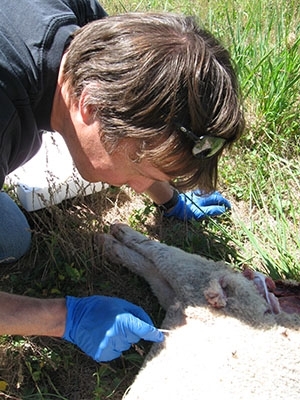NWRC Spotlight - Whodunit? Using DNA to Identify Predators

Wolves, bears, mountain lions, and coyotes can sometimes attack and kill livestock. Many USDA Wildlife Services (WS) field specialists are experts in determining which predator species is responsible for livestock depredation events based on the location of the injuries, tooth marks, tracks, and other clues. But sometimes the clues left at the scene are not enough and more high-tech methods are needed. WS is exploring how predator DNA collected at predation sites can help improve our understanding of predator-prey interactions and the impacts of predators on livestock and endangered species.
Animals shed genetic material (DNA) in their hair, scat, and saliva allowing for the collection of DNA without having to capture and handle an animal. In particular, salivary DNA samples can be collected from animal wounds and carcasses and used to identify the predator species and individual animal responsible.
To improve DNA sample collection from saliva, WS-NWRC geneticists collaborated with the NWRC Utah field station and the non-profit Wildlife Science Center in Minnesota to investigate differences in coyote, wolf, and mountain lion salivary DNA deposits and degradation on cattle and sheep carcasses.
Key findings included the following:
- Wolf salivary DNA was the most abundant and readily obtained from carcasses.
- Salivary DNA should be collected within the first 12 hours after it was deposited.
- After 24 hours, salivary DNA degrades so much that there is about a 50% chance of identifying the animal’s genetic signature. This can be overcome by taking more samples.
- Swabbing the hide for salivary DNA in the laboratory rather than the field led to better results.
These findings resulted in new, recommended protocols for collecting DNA samples from saliva on depredated carcasses. To learn more, please contact nwrc@usda.gov.

